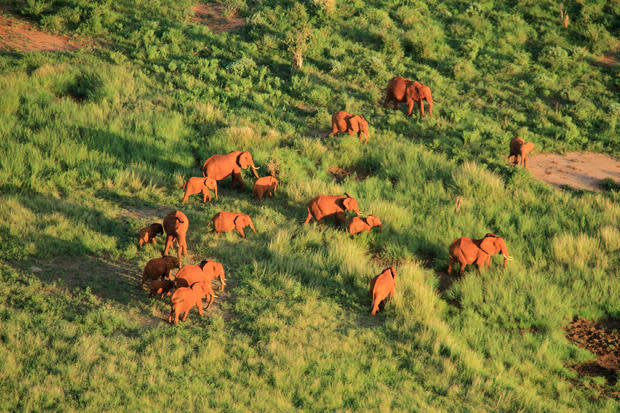GPS serves a pivotal role in big data stickiness

Elephants in Tsavo National Park, Kenya
Image: Elephants Without Borders
The word sticky is making its way into tech dictionaries and parlance. Its most familiar definition is within the context of a website, where it refers to keeping visitors on the site or encouraging them to return often.
But as sticky continues its evolution of a technology definition, I'm going to take a little license with it by expanding it into the world of big data, and exploring how we can build situational contexts around things and people to create new meanings, associations, and "stickiness" of disparate data in a situational context. Global positioning technology (GPS) is perfect for illustrating this point.
Thanks to Google Maps, MapQuest, iPhone Siri, and other purveyors of mobile information, we can key in a GPS locator (like a street intersection) and receive contextual data such as what is around that intersection and, if we are looking for a restaurant, what eateries are nearby, what their menus look like, and their ratings. With GPS, we can also track where we are locationally. This is a simplistic example of GPS apps and data stickiness that already is old hat, and which most of us commonly use.
On the data side of this example, GPS is sticky because of the variety of disparate data sources it attracts as it builds a contextual situation that is useful to the consumer of the information. In the above example, the additional data being pulled into GPS includes satellite mapping that illustrates locations, information about specific locations and businesses along the way, pictorial renderings of travel, and the ability to follow you on your travels.
On an enterprise level, GPS stickiness going much further by providing richer big data contexts than ever before because of the ability of GPS-oriented analytics to aggregate so many disparate data sources and make sense of them.
For instance, in global logistics, GPS tracking capability can trace a transporting vehicle in a remote area, and then combine this information with other data such as the condition of roads, weather, or other complicating factors that pertain to a particular route. The timely receipt of this information enables managers at a distant location to assess situations and to reroute vehicles if necessary, improving ontime delivery results. Even if a situation cannot be avoided, at least there is a clear "on the ground" view of what is occurring.
In another logistics application of GPS, the Boulder/Longmont area in Colorado is combining GPS with historical maps of high-demand emergency medical system response hot spots to assist the cities in best positioning their emergency response vehicles so they are parked closest to the most likely areas where emergency medical responses will occur. The goal is to improve response times to medical emergencies.
In 2011, Verizon changed its privacy policy so it could share anonymous and aggregated subscriber data with outside parties; then, it launched a separate Precision Market Insights division. Its resultant program uses mobile phone GPS and other information, and sells demographics about the people who attend specific events, details about how they got there, or the kinds of apps they use once they arrive. The object is to monetize data that Verizon already has under management. The company piggybacks this information onto GPS technology as a key enabler.
Since then, more companies have explored how to monetize their data under management by aggregating their disparate data feeds and then packaging a product to sell to commercial clients. In this effort, GPS technology has been a major rallying point for sticking the data together into meaningful contexts.
It is this ability of GPS to enlarge the realm of data combinations and inquiries that makes it such an exciting addition to the big data initiatives that virtually every enterprise and academic institution is engaged in today. It can expand what we can do with land, ocean, and vegetation mapping, and it is expanding possibilities for retailers who want to sell to mobile consumers and medical services providers that want to get to the scenes of accidents faster. There is virtually no limit for new business use cases where GPS is likely to play a pivotal role.
Also read
Balancing profits and customer privacy when monetizing big data and IoT (ZDNet)
Technologists and conservationists are teaming up to stop Africa's elephant crisis
Conservis brings big data and analytics to farming with its cloud-based platform
Tech and data converge to create better maps about our shared worlds
Job description: Big data modeler (Tech Pro Research)
Disclaimer: TechRepublic, ZDNet, and Tech Pro Research are CBS Interactive properties.


